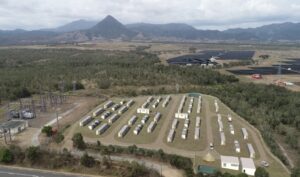Tesla founder and CEO Elon Musk says the so-called Tesla big battery in South Australia is more than 80 per cent complete, and is on track to be switched on in time for the December 1 deadline and the onset of the Australian summer.
“We have also installed more than 80 per cent of the Powerpacks for the South Australia project,” Musk said in a statement accompanying the company’s 3rd quarter results, which as Sophie Vorrath reports included a record loss and a further delay in deliveries of the delivery of the new Tesla 3 electric vehicle.
Customers for Tesla battery storage products are also experiencing delays – in some cases of up to six months according to installers – but that is because of the emphasis put on the South Australia battery project, and efforts to help out Puerto Rico after its ageing grid was destroyed by Hurricane Maria.
The 100MW/129 MWh battery storage project next to the Hornsdale wind farm near Jamestown will be the largest lithium ion battery storage installation in the world when complete, and part of a suite of measures taken to ensure that the lights stay on in South Australia in this and future summers.
“We are well on track to meet our 100-day deadline,” Musk says in the statement. The company won a connection agreement in October, which allowed it to unveil the first half of its installations the same day, and this week won its generating licence for the battery project from the Essential Services Commission.
Part of the capacity will be contracted to the South Australian government for grid security needs – fast response in case of a blackout – while the rest 30MW/90MWh will be deployed by Neoen as an arbitrage play on the wholesale electricity market. See this explainer.
Musk says that energy storage enables a more efficient, cost-effective and sustainable way to build and manage utility grid scale applications, and he expects even bigger installation in coming years.
“We expect this project to lay the groundwork for many similar projects, but at an even larger scale, in the years ahead,” he says .
Tesla has sent solar panels, Tesla Powerpacks and Powerwall energy systems to Puerto Rico in the aftermath of Hurricane Maria, including for this hospital, and is looking to provide long-term distributed energy to the island.
We are also continuing to expand the presence of solar and storage product placement in our stores and service centers. As a result of these efforts, we are seeing a growing number of Tesla vehicle customers also purchasing our energy generation and storage systems, which validates our strategy to cross-sell these products.
Tesla says its installation of energy storage systems had more than doubled in the third quarter, compared to a year ago, and totalled 100MWh. Most of this was from Powerwall deliveries, and did not include the yet to be finished Tesla big battery.
The company also reported 109MW of solar installations in the quarter, which was lower than previous quarters but represented a higher ratio of direct sales rather than leases, while solar roof installations were expected to “rap slowly” in the current quarter as the production process moves to a new gigafactory in Buffalo.
“As we fine tune and standardize the production and installation process, we expect to ramp Solar Roof production considerably in 2018,” it said.









